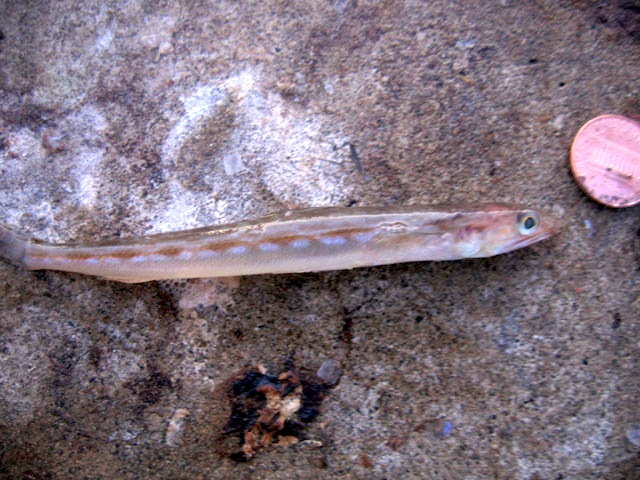
California Lizardfish — Goleta Pier
Species: Synodus lucioceps (Ayres, 1855); from the Greek word synodus (the ancient name of a fish in which the teeth meet), and the Latin word lucioceps (pike head).
Alternate Names: Gar, barracuda, candlefish. Called lagarto lucio or chile lucio in Mexico.
Identification: They are cylindrical shaped with a broad lizard-like head and a mouth full of large canine-like teeth; the snout is almost triangular. Their coloring is mostly brown or greenish-brown above with a brassy luster on the side; blackish stripes along the lateral line; some criss-cross lines running at angles from the lateral line to the back; sides and belly usually a light gray; lower jaw and fins yellow. Young fish have a series of blue-colored diamonds along the lateral line.
Size: Up to 25.2 inches and around 4 pounds; most caught off piers are under 14 inches.
 California Lizardfish — Cayucos Pier
California Lizardfish — Cayucos Pier
Range: From Guaymas, Mexico, and Gulf of California, to Cape Beal, British Columbia. Listed in most “fish” books as an uncommon catch, especially north of Point Conception, and rare north of San Francisco. I used to agree. I fished California piers for 17 years before I caught my first lizardfish, a fish from the Newport Pier in 1978. Four years later I caught my second, a fish at Port Hueneme, and then in 1984 a third was caught at Wharf #2 in Monterey. It would stay that way, basically an occasional, incidental catch into the mid-90s when they began to show up more regularly. Then, in 2006, it seemed their numbers took off and in the intervening years they have become a regular catch at many if not most piers from San Dego north to Santa Cruz. In 2013 reports were coming in of vast numbers of lizardfish from San Diego north, and in personal visits to Stearns Wharf (Santa Barbara), Gaviota, Port San Luis, Avila, the Morro Bay T-Piers, Cayucos, San Simeon and Wharf #2 in Monterey, they seemd to literally cover the bottom and anglers using Sabiki-type bait rigs were bringing in 4-6 fish every cast. Why the change? I haven’t heard a good reason although they do seem to show up most commonly in cold-water years.
Habitat: Prefers shallow, sandy areas 5 to 150 feet deep. Lizzies are ambush predators that spend most of their time sitting motionless on the bottom with the body at a slight angle (using their large pelvic fins) waiting for food to swim by. They then dart out at a fairly amazing speed to grab their meal with their long, pointed teeth.
 California Lizardfish — Cabrillo Pier
California Lizardfish — Cabrillo Pier
Piers: Once uncommon but now common at many piers—Imperial Beach Pier, Crystal Pier, Oceanside Pier, Balboa Pier, Newport Pier, Venice Pier, Malibu Pier, Port Hueneme Pier, Stearns Wharf, Goleta Pier, Port San Luis and Wharf #2 in Monterey.
Shoreline: Rarely caught by shore anglers.
Boats: Taken occasionally on skiffs and kayaks fishing in bays or shallow water areas.
Bait and Tackle: Commonly caught when fishing the bottom for other species. Seems to hit almost any bait but the key is to keep the bait moving. I have caught them on cut bait, strips of squid, pile worms and Sabikis. Use light or medium tackle and a size 6 to 2 hook. Several people have reported that small lizardfish themselves make good bait for halibut, another predator species that mimics the lizard’s behavior.
Food Value: Reportedly, they are good to eat but quite bony. Some people say the flesh has a strong “fishy” odor and an iodine taste, but others say they are good eating. I’m not sure. 
Comments: You can’t always choose your relatives (and luckily mine are a nice group). But consider the poor lizardfish. Lizzies are a cyclosquamate fish placed in the order, Aulopiformes, along with a dozen or so other families. Nothing strange about that except that all of those other families are deepwater fish, what one Ichthyology book (Fishes, Moyle and Cezh) calls “a mixed bag of odd fishes.” Included are the barracundinas, sabertooths, pearleyes, lancetfishes, greeneyes, spiderfishes and grideyes. All of these either occupy the water column of the deep sea or are actual deepsea bottom-dwellers. Only the various lizardfish are considered inshore fish (although two species are deepwater fish). And while both the California lizardfish and Atlantic lizardfish reach fairly cool waters, most lizzies call tropical and subtropical waters their home.
 California Lizardfish — Avila Pier
California Lizardfish — Avila Pier
I found that out during a trip to Hawaii in 1993 while chaperoning a group from Anderson Valley High School. We were staying near Waikiki Beach and several of us headed over to the beach to do a little surf fishing. In two hours I only managed three fish but one surprised me by being a lizardfish—a variegated lizardfish (Synodus variegates). It was the only lizardfish I caught on that trip although a return trip to Waikiki Beach two years later yielded up another variegated lizardfish. Two trips doesn’t mean they’re common for that beach but they were certainly common for me.
Notwithstanding their oddball cousins, lizardfish do have one honor. Not too many fish have had Naval vessels named after them. Not so with the typically maligned lizardfish. The USS Lizardfish (SS-373) was a Balao-class submarine commissioned December 30, 1944. Built in Illinois, she was towed down the Mississippi River to Algiers, Louisiana before putting out to sea where she traveled through the Panama Canal on way to Pearl Harbor. Soon after, she was headed out to the Java Sea and South China Sea where she was successfully engaged in several battles. The ship earned one battle star for World War II but the end of the war brought an end to the need for her service. The ship was decommissioned in June 1946 after less than two years of service.

















Thanks for the lovely and informative blog, Ken!
I’ve got back into fishing again after a 20 year hiatus, and in the last two weeks, encompassing about 5 trips to the jetties/beach, my brother and I have pulled in at least 30-40 lizardfish (yeah, seriously), primarily from the main channel of Marina del Rey around the jetties exiting the marina. We’ve been using 1/2oz and 5/8oz Kastmaster spoons, and have also landed a small barred sandbass, an 18″ barracuda, and a handful of very nice size mackerel. In the surf to the northwest (between marina and Venice pier) we’ve caught a bunch of BSPs and a couple of guitarfish. (on Big Hammer perch grubs) and thankfully, no lizardfish! Cheers and tight lines!